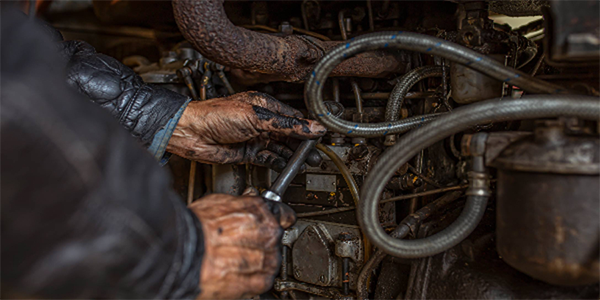With fluctuating fuel costs, a predictive maintenance program with telematics data can provide substantial fuel savings to reduce operating costs.
Proper vehicle maintenance is essential for the safe and efficient operation of your fleet. But did you know that it can also improve fuel economy by as much as 5% to 10%?
Not only that, it can also:
- Improve vehicle uptime
- Increase resale value
- Enhance driver safety
- Reduce Commercial Vehicle Safety Alliance (CVSA) violations and fines
Let’s look at 10 of the most important components that impact fuel economy and see how a preventative maintenance program supported by telematics can help.
Engine oil
Low engine oil levels can create friction and place additional strain on the engine, which results in reduced fuel mileage. Meanwhile, too much engine oil can cause oil churning and spin losses, reducing fuel economy by over 2%.
Engines run more efficiently with clean oil, so schedule appropriate oil change intervals depending upon the age of your trucks, the lubricants used and the filter technology.
You can also use lower-viscosity oils to improve fuel economy. Switching to a manufacturer-approved, lower-viscosity engine oil can improve fuel economy by between 0.9% and 2.2%. But maintenance staff and drivers should be aware of which engines can receive the lower high-temperature and high-shear viscosity FA-4 oils, because these are not backwards compatible with earlier engine technologies, unlike CK-4 lubricants.
Intake and exhaust system and diesel particulate filters
Poorly maintained intake and exhaust systems can decrease fuel efficiency by as much as 5%.
Clogged air filters can also cause the engine control modules to burn additional fuel. This makes the exhaust fuel-rich, which can lead to faster loading of the Diesel Particulate Filters (DPF) and more regeneration cycles. Excessive regenerations further reduce fuel economy because they use fuel to create the necessary high temperatures.
With a wireless filter monitoring system integrated with your telematics, you’ll know the status of the filters and fluids in your fleet.
Engine cooling
Engine cooling fans should run as required to cool the engine. If a fan is running constantly due to issues with the fan clutch, thermostat switch or low coolant levels, it can reduce the fuel efficiency by as much as 8% to 12%.
Low coolant levels can also force your cooling fan to run harder, creating a risk that engines overheat. This risks damage to certain parts that could result in major, costly repairs.
Air compressors
Air compressors produce air for brake systems and other air accessories and should function no more than 25% of the operating time of the vehicle. If a compressor is working excessively, it can result in fuel economy losses of 2%.
A faulty air compressor is often the result of another system fault. Telematics with in-vehicle diagnostics can help you to identify the root problem for repair.
Wheel alignment
Misaligned wheels increase rolling resistance, making trucks work harder to overcome drag and drive straight, increasing fuel consumption by up to 2.2%. A misaligned wheel that’s just a quarter of a degree off center travels 10 to 15 feet sideways for each mile traveled, which increases tire wear.
Preventative maintenance through your telematics system can help identify misalignments before they result in increased fuel consumption or excessive tire wear.
Tires
Underinflated tires can cause a 1% reduction in fuel economy for every 10 psi of under-inflation. Without a tire pressure monitoring system (TPMS), on average 34% of a fleet’s tires have been found to be underinflated. Underinflated tires are also more likely to overheat and blow out.
For Class 8 fleets, trailer tires have the largest effect on fuel economy, as opposed to the drive or steer tires. Trailer tires are often poorly maintained, with many fleets using their older tires in these positions to run out any remaining tread.
A TPMS integrated with your fleet telematics system can provide real-time tire pressure and temperature monitoring to help you keep your tires at optimal pressure.
Fuel filter systems
Clogged filters prevent sufficient fuel from passing through it, overworking fuel pumps and burning excess fuel.
Current diesel engines operate at a higher pressure than older engines. These systems are less tolerant to contamination or blockages, which would have a damaging effect on fuel injectors and negatively impact fuel economy.
Aerodynamic devices
Class 8 trucks consume 50% of their fuel to overcome air resistance on highways. You can fit a number of devices to your vehicles to improve aerodynamic performance and create at least 15% fuel savings.
To function at their best, these aerodynamic devices need to be damage free. With a telematics system to monitor fuel consumption trends, you can identify vehicles that are consuming more fuel due to malfunctioning aerodynamic devices.
Electrical systems
If a battery, starter motor or alternator are not functioning properly, they can negatively affect fuel economy. Mileage, driving conditions and vehicle age can all impact the electrical system. Regular preventative maintenance will help you identify and resolve issues quickly, before they become expensive problems.
A preventative maintenance schedule that runs through your telematics system can catch problems early.
Air conditioning
If an air conditioning system is malfunctioning, it may have to run longer than necessary to keep the cab cool, wasting fuel. Preventative maintenance of the A/C system should check coolant levels and the condition of the drive belt, condenser and evaporator coils.
Predictive maintenance
A predictive maintenance platform analyzes hundreds of thousands of telematics data points from vehicles of all models and classes to pick out patterns that have caused past failures.
You can perform continuous analysis of major vehicle components with a predictive maintenance solution combined with Geotab telematics. You’ll see that data in real-time along with alerts for high-probability failures for each vehicle, so you can proactively schedule repairs before any major damage is done. This leads to reduced fleet fuel consumption, increased vehicle uptime, reduced maintenance and recovery costs and prolonged vehicle life.
Learn more about how predictive maintenance can help proactively identify patterns that lead to failures.

















